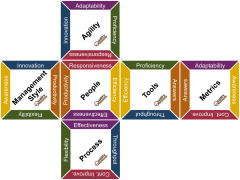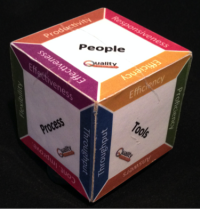… Multiplies Value “At the Edges”

“Here is Edward Bear, coming downstairs now, bump, bump, bump, on the back of his head. It is, as far as he knows, the only way of coming downstairs, but sometimes he feels that there really is another way, if only he could stop bumping for a moment and think of it. And then he feels that perhaps there isn’t.”
From Winnie the Pooh, by A. A. Milne
Over the last six weeks, we’ve covered the six dimensions, and I congratulate you for sticking with me. The discussions can be a bit theoretical and dry, but knowledge of those building blocks forms the foundation for the rest of the material.
Continuing with the “block” analogy, we can think of the six dimensions as sides of a cube. That allows us to examine the “edges,” and see what happens when the dimensions on two adjacent sides move from inhibiting to enabling. This will allow us to get better insight into some of the tangible results of our efforts.
The Edges

A cube has 12 edges, and we’ll look at each. Before we start, we need to recognize that we have 3 sets of opposite sides, which have no common edges. We’ve created the cube to put those dimensions that have the least significant interactions on opposite sides:
- People : Metrics – Certainly people are involved in the processes and tools used to collect and report metrics, but more significant interactions are with these two and the other four dimensions.
- Process : Agility – Agility is an aspect of processes (maybe even a subset), and there aren’t any significant interactions between these dimensions.
- Tools : Management Style – Management style can impact tool selection and use, but the other dimensions have more significant interactions with each of these.
Let’s look at the other 12 pairings that are represented by the cube edges and the impact of moving both from inhibiting to enabling:
- People : Process –> Effectiveness – Enabled workers using appropriate processes can be very effective. On the other hand, even fully enabled workers (from the People dimension perspective) with inhibiting processes will not be nearly as effective, and excellent processes implemented by poorly selected and unprepared workers will be ineffective.
- People : Tools –> Efficiency – The best tools by themselves don’t do much, but, when coupled with enabled workers, will allow those workers to be more efficient.
- People : Agility –> Responsiveness – Enabled workers in an agile environment can be responsive to internal and external opportunities and challenges. Take away the agility, and those non-agile processes can encumber even the best workers.
- People : Management Style –> Productivity – An enabling management style allows the staff to focus on the real job. An inhibiting management style, on the other hand, can significantly reduce productivity as workers take their focus off the job at hand and worry about what the boss will do next, and whether they’ll be the target.
- Process : Tools –> Throughput – Similar to the People & Tools interaction, the proper tools increase throughput of a good process.
- Process : Metrics –> Continuous improvement – Good processes are in a state of continuous improvement, and we need the proper metrics to identify the best improvement opportunities.
- Process : Management Style –> Flexibility – When processes and management style are both enabling, the organization gains flexibility, principally due to worker focus on the actual job. Conversely, an inhibiting management style can bring down otherwise enabling processes, because workers will be distracted as they deal with the uncertainty and fear that often accompany a poor management style.
- Tools : Metrics –> Answers – Metrics by themselves can provide answers, but without the proper (enabling) tools, the answers will be limited. More importantly, the proper metrics supported by the right tools can provide answers to the right questions.
- Tools : Agility –> Proficiency – While agile processes and decision-making enable better responses to internal and external opportunities, when aided by the appropriate tools, the teams become more proficient and capable.
- Metrics : Agility –> Adaptability – In general, agile organizations and teams can adapt faster than their non-agile competitors. When the right metrics are added to the mix, the teams increase their adaptability because they can focus on the best opportunities.
- Metrics : Management Style –> Awareness – Management typically respond to issues in a priority-based fashion. One of the challenges for them is knowing how to set those priorities. The correct metrics will provide the awareness needed to make those decisions, and proper management style will help ensure that the metrics are accurate.
- Agility : Management Style –> Innovation – When we enable agility, specifically communication, stakeholders contacts and decentralized decision-making, and couple that with the proper management style that includes empowerment and collaboration, we get organizations that have the right environment to identify and deliver innovative products and services.
What’s Next
We’ve covered the framework, the six dimensions and the power of the “edges.” Now we need to do something with that information. Next week, we’ll start looking at the Quality Enablement Cycle, which maps how we use the framework to identify and implement the changes needed create A Better Workplace.
Until Then …
“He who will not apply new remedies must expect old evils.”
Francis Bacon

What are your thoughts? Please share your comments in the block below.